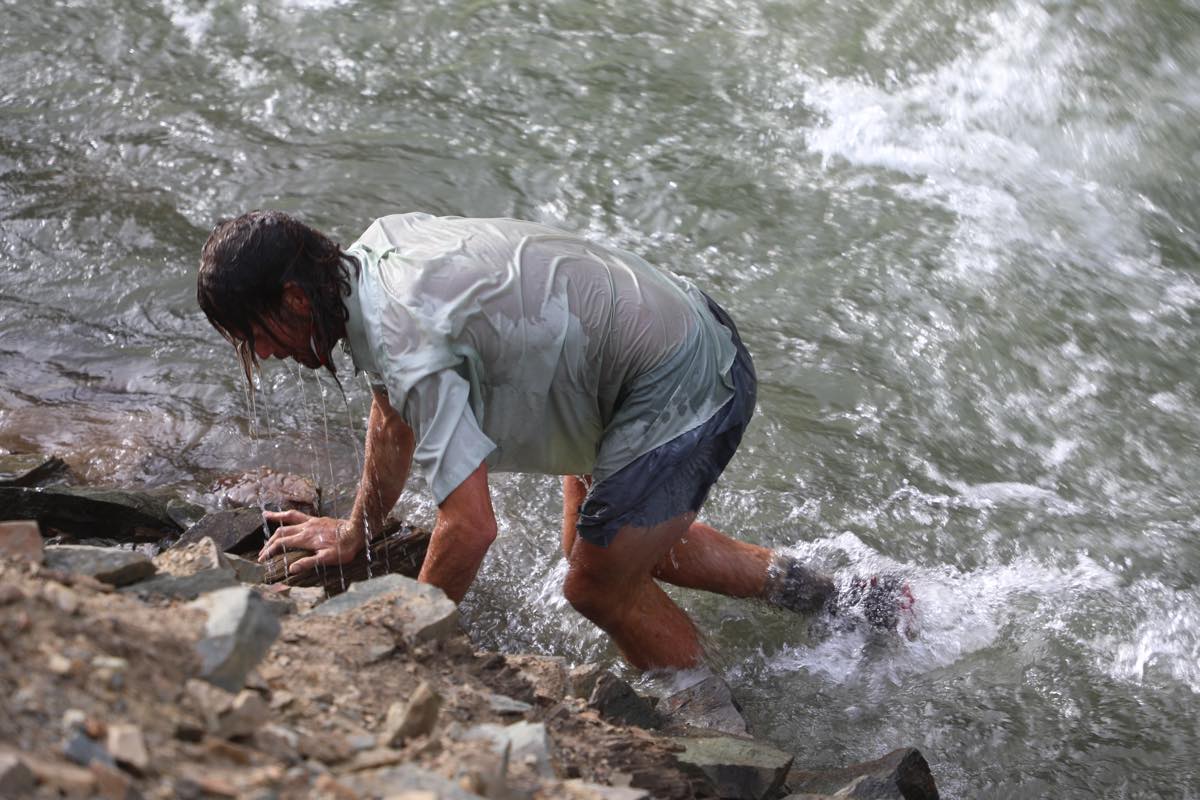It’s that time of year where my coaching-email inbox is flooded with athletes worried about upcoming hot-weather races. Running in extreme temperatures takes its toll on all the human body, and can truly make ultrarunning a battle of attrition. Indeed, our worries are based on a rational understanding of heat’s negative effects on athletic performance and the discomfort it creates.
But is impending doom really on the horizon? The answer is no! A number of science-backed strategies exist for getting cool before you race and staying cool once the gun goes off. We’ll talk about which cooling strategies currently exist, why they work, and how you can effectively apply them in your race-day strategy. Our ultimate goal with this article is to relieve the stress you might feel when planning for a hot race.
What is really cool (literally) about this area of research is that a ton of it is happening right this second. With the 2020 Summer Olympics in the hot climate of Tokyo, Japan right around the corner, physiologists and national sport governing bodies are scrambling. Tokyo 2020 will likely be the hottest Olympics on record, and tricks to keep athletes cool before and while they perform might mean the difference between a medal or no medal.
We trail and ultrarunners compete for much longer than Olympics events. Thus, you might be wondering, Can we really learn from our shorter-distance sistren and brethren? The answer is, yes, with some added nuances, we can take a lot away from the research conducted in the field and in the laboratory on our road- and track-running counterparts. With that, let’s dive in.

Pam Smith using the mid-cooling strategies of ice in her hat, ice in her neck bandana, and keeping her white cotton shirt wet while on her way to winning the 2013 Western States 100. Image: iRunFar/Meghan Hicks
We Are Inefficient: The Basics of Humans and Heat
Energetically, humans are inefficient creatures. When we exercise, a mere 20 to 30% of the energy we produce is converted into movement, while the other 70 to 80% of that is released as heat (1). Compared to when we are at rest, our body’s heat production during exercise will be three to 12 times greater (16).
As runners, we have two major heat sources to mitigate when racing in hot climates:
- the internal heat our bodies produce with each muscle contraction, and
- the external heat from the environment around us (3).
To better understand the exchange of heat between our bodies and the environment, you have to understand that there are four major ways we can obtain and lose heat:
- Radiation: Heat transferred via infrared rays, both direct and indirect (reflection of rays).
- Conduction: The transfer of heat through physical contact between two objects, for example your foot on hot pavement.
- Convection: Heat transferred through the movement of water or air over the skin, for example a breeze or rain moving across your skin and cooling you down.
- Evaporation: Loss of heat through the conversion of water to gas, or specifically the evaporation of sweat or water from the surface of your skin.
These four components act together to both heat us up and cool us down and are in constant flux.
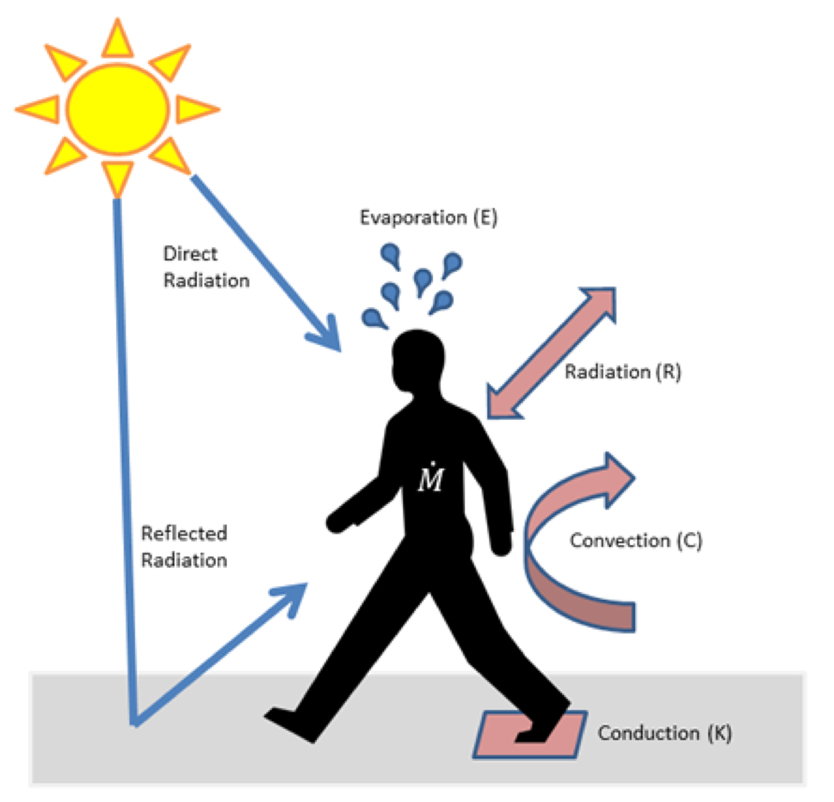
There are several ways we both release heat into and receive heat from the environment, including radiation, conduction, convection, and evaporation. Image: Usariem.army.mil/index.cfm/modeling/scenario
When it comes to the external environment, our physical performance starts to decline when the temperature we’re exercising in reaches 21 degrees Celsius (69.8 Fahrenheit). In studies comparing running time-trial performances in 30 Celsius (86 Fahrenheit) versus 14 Celsius (57 Fahrenheit), athletes covered as much as 10% less distance in 15 minutes in the heat (5). It should be noted that in that study, the humidity was held constant and generally as humidity increases alongside heat, your performance decreases as it eliminates your ability to dissipate heat via evaporation. Over longer distances, we should expect the toll of the high temperatures and/or humidity to be further exacerbated.
There are number of theories as to why we fall apart when temperatures skyrocket, but the main idea is that our core body temperature eventually reaches a ‘critical’ level. We think that critical level is right around 40 Celsius (104 Fahrenheit). At this level our body starts to shut down, or experience what’s called hyperthermia- (elevated core body temperature) induced fatigue. Even a fraction above 40 Celsius moves you into a really dangerous area where you can experience heat stroke, which is a severe heat illness that can be fatal and is a medical emergency. (This article describes more about heat stroke and other heat illness.) But we’ve learned that 40 Celsius is not a perfect shutoff switch, where your body suddenly stops working. Instead, it’s the core body temperature where many studies have shown that people will voluntarily stop exercising or slow down (1).
We also believe that the gradient (difference) between core body temperature and skin temperature is important. What this means is that when the surface of the skin is kept adequately cool, people can sustain performance with core temperatures nearer to the critical 40 Celsius (1). In a 2014 study looking at 60 healthy male and female runners, they found that when skin temperature reached 35 to 35.5 Celsius, participants started to falter (18). What can be hard to wrap one’s brain around is that this is only about one to 1.5 degrees Celsius higher than what’s considered normal skin temperature, 34 Celsius. The difference is significant though when it comes to dissipating heat across a gradient, with our normal core body temperature being 37 Celsius. The closer the temperatures of our core and skin, the harder it is for our body to move heat to and off the skin.
Heat stroke, although severe, is not super common. In a three-year study at the Flying Pig Marathon, they saw 26 cases of heat stroke in the half and full marathons. Twenty-five of the 26 were successfully treated with cold-water immersion, where one participant collapsed on course and was treated successfully in the hospital for four days. This number of confirmed episodes of heat stroke comes out to approximately 5.64 cases for every 10,000 runners (17). That being said, there were two known, serious cases of heat stroke in healthy males, one fatal, in the trail running community in 2018, so we proceed with caution.
How do we stay cool during endurance running? There are two main methods for beating the heat:
- Pre-cooling: These are cooling strategies you use before your event.
- Mid-cooling: These are cooling strategies you use during your activity/race. (This used to be called per-cooling.)
The Science of Pre-Cooling
The concept of pre-cooling has been pretty thoroughly researched over the past two decades. The idea is that you can utilize pre-cooling strategies to rapidly remove heat from the body before exercise with the hopes of creating a larger heat-storage capacity (1). Pre-cooling strategies include cold water-immersion, ice packs applied to the skin at key areas of blood flow (the armpits, groin, and around the neck), wearing ice-cooling garments (such as ice vests), cold-air exposure, and ice-slurry ingestion (drinking crushed ice with water) (5).

The results of a a meta-analysis (a research paper that does an exhaustive review of the scientific research on a subject to form a consensus statement) where exercise was performed with an ambient air temperature of 30 degrees Celsius or greater. Image shows the percent performance improvement in time to exhaustion or time-trial performance in runners and cyclists for each of the pre-cooling strategies evaluated. The meta-analysis found mixed-method cooling, or combining several strategies, to be the most effective. Image: Bongers, C. C., Hopman, M. T., & Eijsvogels, T. M. (1)
Overwhelmingly, pre-cooling has been shown to be an effective means of reducing thermal strain and therefore increasing athletic performance by decreasing core body temperature prior to competition (5). The most effective practices seem to be the ones that provide aggressive cooling and cover major parts of the body or that involve using multiple pre-cooling techniques (1). Generally cold-water immersion via a tub or shower to rapidly cool the core body temperature and skin temperature is highly effective, but not always practical (1). A more practical strategy would be to cover your torso, neck, and head with wet cold towels for eight to 30 minutes.
Pre-cooling protocols’ positive effect on performance more or less goes away after 20 to 25 minutes of exercise (1), and so when it comes to longer trail and ultrarunning events, cooling during the event itself (mid-cooling) might be a better strategy.
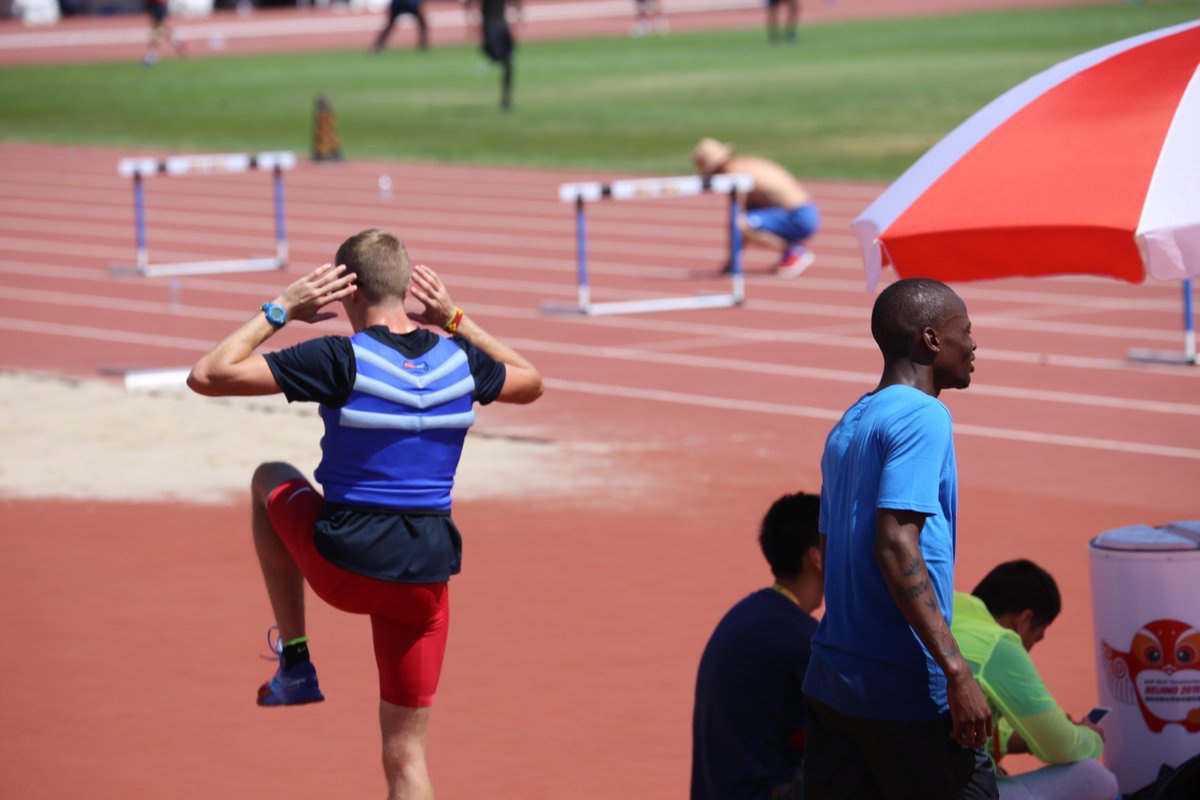
A track-and-field athlete warms up while wearing an ice vest before his event. Image: IAAF Twitter account
The Science of Mid-Cooling
Mid-cooling, or during-activity cooling, has received a lot more attention over the past five years as championships events have heated up and different cooling strategies have become more practical to administer while on the run. That being said, ultrarunning has a distinct advantage over traditional sports that these studies are conducted in. Unlike on the track or a road marathon, ultrarunning events have an abundance of potential ways for athletes to cool themselves down. In many races we have natural cooling features (water features on course), regular access to family and/or crew members who can provide cooling strategies, well-stocked aid stations at hot events to help cool runners down, and the clothing and gear we wear (love a good running pack and ice bandana). That being said, there is no real field research on cooling strategies in an ultrarunning setting, however we can extrapolate from the research done on cyclists, ironman athletes, and marathon runners.
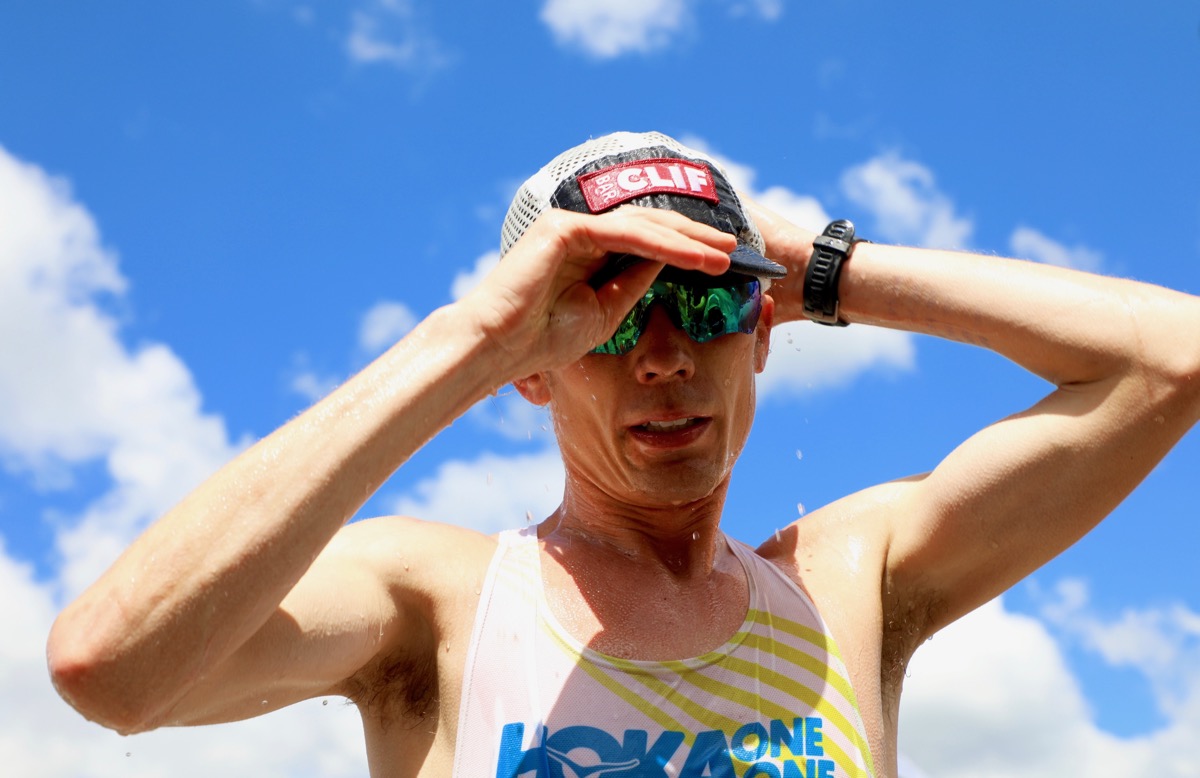
Jim Walmsley after dunking his hat in water to stay cool during the 2017 Tarawera Ultramarathon. Image: iRunFar/Meghan Hicks
There’s a lot of overlap between pre-cooling and mid-cooling strategies. The major difference between the two is that in pre-cooling you are trying to effectively drop your core body temperature. This is not as practical during an event because you can’t adequately provide the magnitude of cooling needed to drop core body temperatures while moving. Instead, on the run, mid-cooling is focused more on cooling skin temperature which allows you to maintain that temperature gradient between your core and your skin. What this does is to allow for heat mitigation, sending blood to the skin to release heat, and to try to circulate cooler blood back toward your core. Compared to pre-cooling, mid-cooling is more about walking the tight rope. As the temperatures creep up and stay up, continual maintenance is key.
What are the effective mid-cooling options? First, it’s important to remember that during exercise the best way for us to get rid of the excess heat is primarily through sweat or other water evaporating off the surface of your skin. This can be difficult and limited if humidity is high, as there is nowhere for that water to go. However, wind is your friend, and a breeze can help this process along, even in humid environments.
When it comes to cooling yourself down during a race, the strategies that are going to work best for you are: ice packing on the torso (research would say an ice vest but as trail runners we can use our running vests and sports bras for this purpose), icing the neck and head (ice bandanas, collars, and running hats), icing other peripheral arteries (in ultra-speak this is shoveling ice into our arm sleeves), wearing loose and light-colored clothing to facilitate heat dissipation, limiting conductive heat (dark colors), increasing evaporation, and drinking cool fluids (14, 12, 8, 1, 6). How effective are these tactics? When applied in a research setting, they improve performance anywhere from nine to 18%. These improvements have been shown over much shorter times and distances, 15 to 90 minutes, than when we tackle 30- to 100-mile races. But you get the gist (8).
How do they work? Well, aside from evaporative cooling, which all of these try to utilize, the other crucial element these strategies employ is continually helping to maintain that temperature gradient between your core and skin temperatures to allow all that heat you are producing to hopefully go somewhere.
All that being said, if at any point you need a full reset, taking an extra 10 minutes at an aid station to really get ice packed on you, cold wet towels placed on you, or hanging out submerged in a water source, it can potentially bring your core body temperature down enough to more or less start off fresh as you’ve once again increased your body’s capacity to build and hold heat. There are a number of incredible success stories of Western States 100 runners who spent several minutes submerged in water bodies on the course during the heat of the day and were able to perform very well afterward.
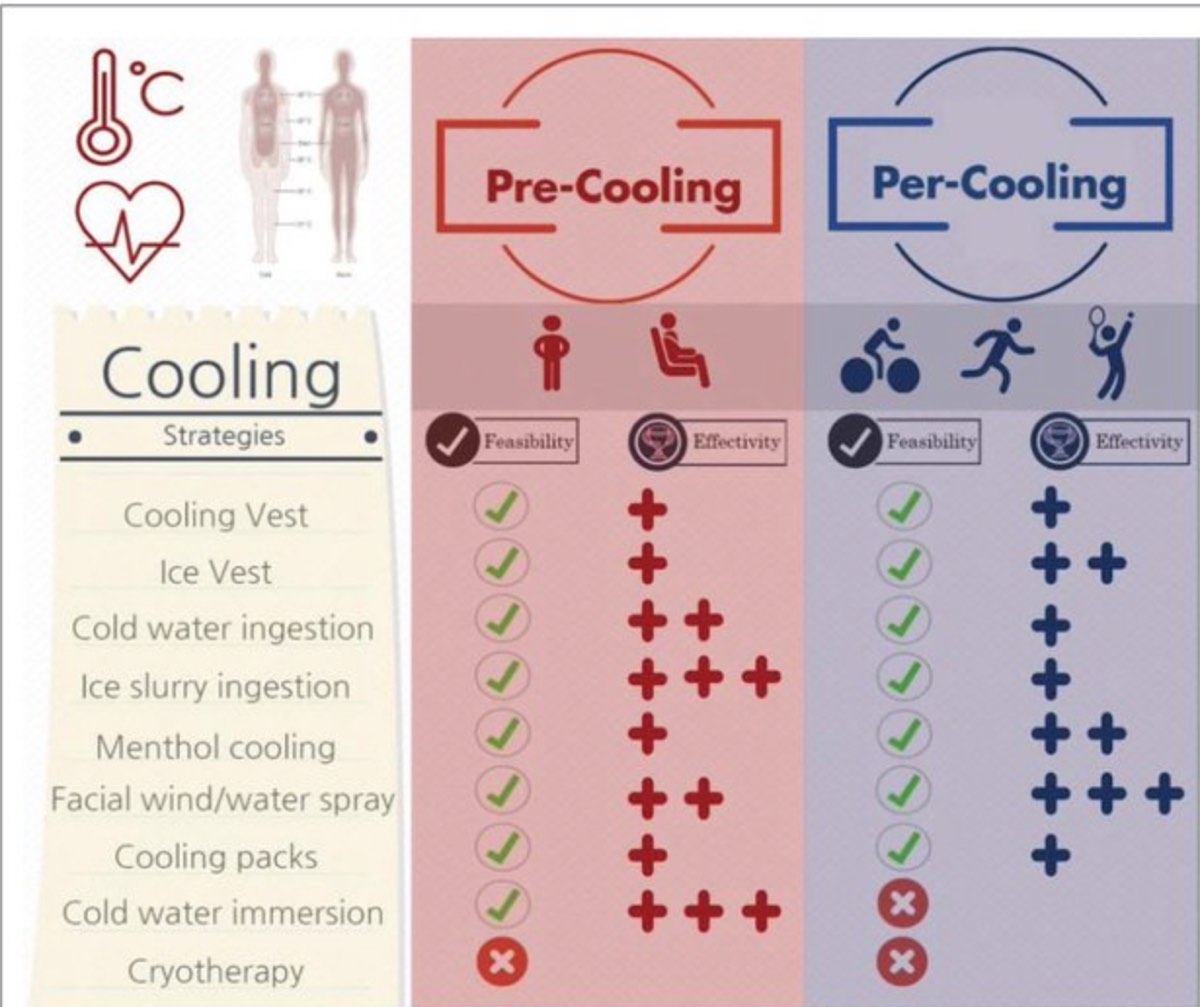
A breakdown of pre-cooling and per-cooling (what’s now called mid-cooling) strategies for pre- and during-race. Green check marks signify the feasibility of the strategy and its (+) small effect, (++) medium effect, or (+++) large effect on performance. Remember these are laboratory- and controlled-environment specific, but we can still pull this information into strategies for the trail. Image: Bongers, C. C., Hopman, M. T., & Eijsvogels, T. M. (1)
More Thoughts on Some of the Surprising Cooling Strategies
Some of the more interesting things about mid-cooling that I did not know was the difference between consuming an ice-slurry drink versus a cold-water drink. It turns out that an ice-slurry drink might actually be so cold on the run (compared to pre-run) that you can cause receptors in your stomach to be stimulated that drastically reduce your sweat production. When this happens, there is this weird mismatch between your body and brain, where your brain thinks you are colder than you actually are (2). When we are relying on evaporative cooling to help dissipate heat, this could be a big negative (3, 11, 12).
What does that mean for you? Consuming cold liquids is okay, they can even increase your thermal comfort, but consuming an ice-slurry (think crushed ice with water) is worth saving for pre-hot workout or pre-race times. This is a pretty new idea in the literature, hence it not being represented in the image above. But that’s science!
Another common theme in some of the newer literature is the psychological impacts of competing in hot environments, because although there are physiological limiters as our core and skin temperatures rise, the psychological strain of running in the heat can also take a serious toll on your performance. It’s hard to completely separate the two but there has been some research trying to specifically address the psychological side of competing in the heat.
Being sprayed, dunked, or doused with cold water decreases our sense of thermal strain by increasing our thermal comfort, or our ability to tolerate the heat. More specifically, head and neck cooling has been recently shown to decrease athletes’ rating of perceived exertion for a given workload and thermal discomfort. Additionally, head and neck cooling also improved working memory capacity, and limited negative impacts of the heat on rapid visual processing (4). Although some of this is hypothetical, it’s possible that there are strong psychological components of any of these strategies, like being misted with water or having wind blown in your face. It’s possible that the mist could be causing added evaporative cooling with the wind helping to dissipate heat, but it could also be that it simply makes you feel better. We might not ever be able to completely separate the two because it’s hard to create a placebo for wind, but a placebo that works is not a bad thing.
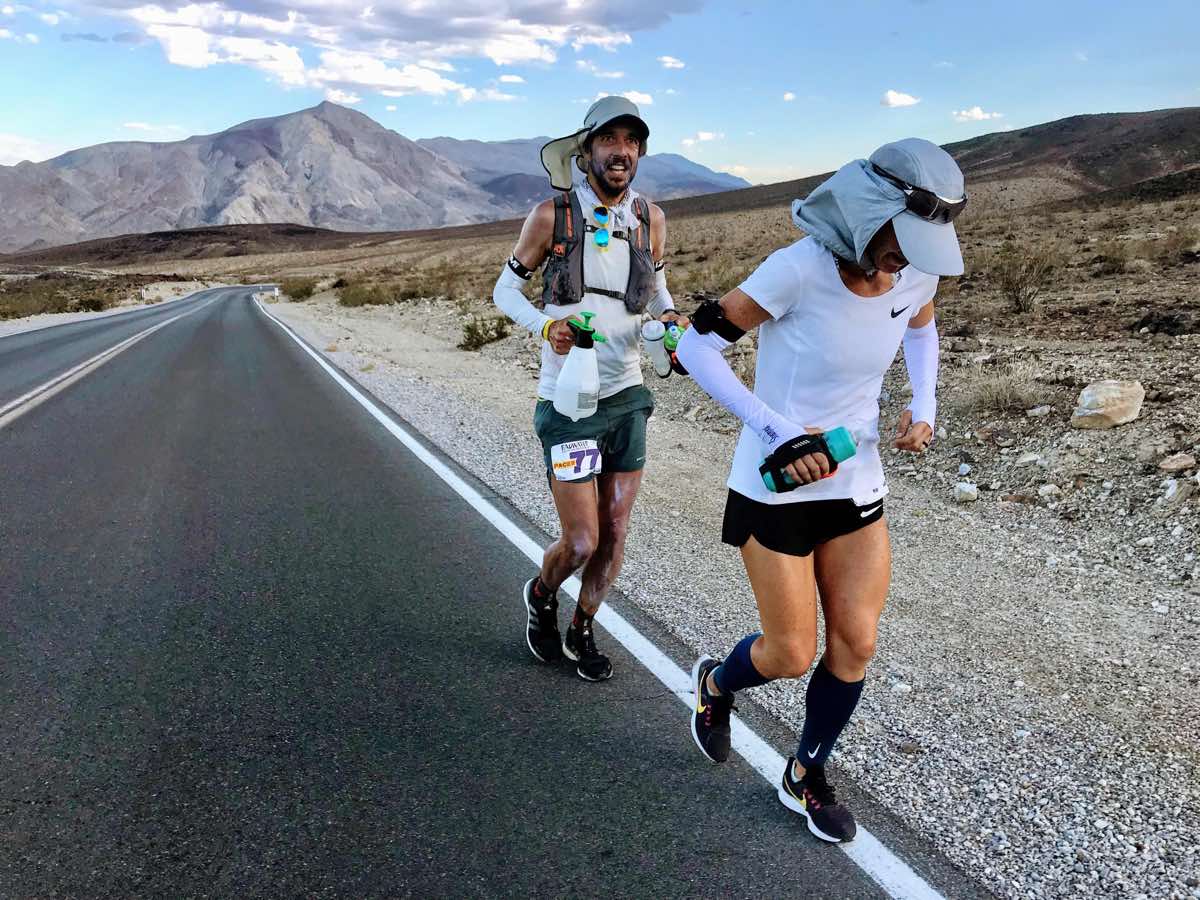
Sally McRae’s crew carrying a spray bottle they used to spray her head, face, neck, and body during the 2018 Badwater 135. Image courtesy of Sally McRae.
Finally, let’s talk about a cooling strategy that is at the edge of our psychological impact of trying to feel cool in the heat. Menthol, or that minty-fresh coolness of peppermint, has recently become a hot topic in exercise science. For years, scientists have tried the topical administration of menthol via gels and sprays as a means of trying to trick athletes into feeling cooler with little results (8). More recently the ingestion, swishing, or gargling of a menthol mouth wash has become the area of interest. Similar to what we talked about in our article on cramping with regard to other substances, there are believed to be transient receptor (TRP) channels in the oral cavity and oropharynx that are stimulated by menthol. TRP channels are ion channels, or excitable cells that convert chemical or mechanical messages into electrical signals. These help to mediate a variety of different sensations like pain, tastes, hot, cold, and pressure. When activated, these channels relay the sensation of cold to our brain, allowing us to perceive that we are physically cooler than we actually are.
However, similar to the issue with drinking ice slurries for mid-cooling, this could have unintended negative consequences (11). In the ultra-context, take great care when trying to use menthol to battle the heat. If the false signal to your brain continues for long enough, telling it that you are cold when you are indeed continuing to heat up, there could be extreme negative consequences. Although periodically being relieved of the oppressive heat can lead to short-term increases in performance (effective for 20 to 70 minutes), you need to make sure your body isn’t completely ignoring its slow rise in temperature (15). It turns out that modified perceptive signals can be much stronger than the physiological one, and you don’t want to mouth wash yourself to heat illness (4).
So why am I telling you how cool the menthol trick is if it’s potentially harmful? I think we are going to hear a lot more about it from popular and mainstream media outlets as the 2020 Olympics approaches, and you should be in the know. Menthol is a trick for the tool box, but should be used in addition to other mid-cooling strategies and used with care.
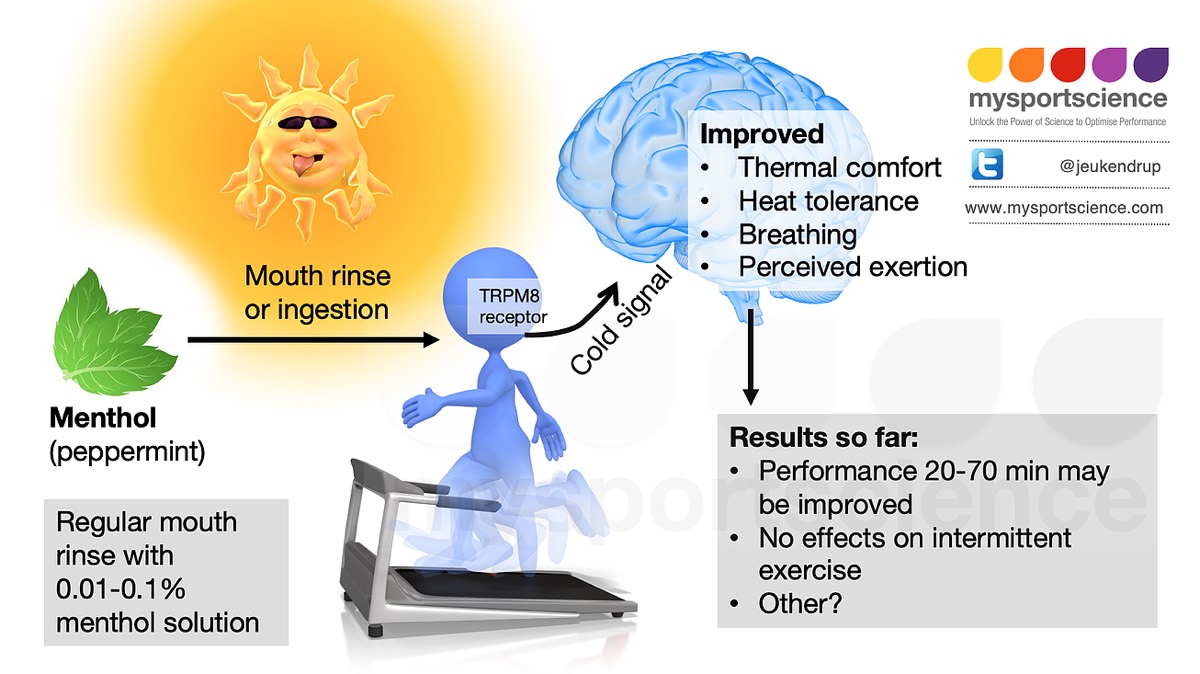
There are mixed results, but it appears that rinsing or ingesting menthol-containing product might temporarily improve thermal comfort and therefore improve performance. Image: Mysportscience.com/single-post/2019/03/25/Can-peppermint-improve-performance-in-the-heat
The Takeaways
- Heat acclimation is your friend: As discussed in a previous article, appropriate heat acclimation improves our ability to dissipate heat and decreases cardiovascular strain by increasing our blood plasma volume and making us more efficient sweaters. Additionally, heat acclimation improves our thermal comfort, which allows us to handle the psychological impacts of training and racing in the heat (4).
- Avoid sunburn: Sunburnt skin can exacerbate your feeling of being too warm on the run and can actually impair your ability to thermoregulate because sunburn can affect the responsiveness and capacity of your sweat glands (14).
- Sunscreen or not to sunscreen: It’s logical that something like antiperspirant would disrupt our ability to sweat; after all it’s in the name. But what about sunscreen? I have good news and bad news. In a study looking at healthy male and female athletes, inorganic chemical sunscreens disrupted sweat rates to the same extent as antiperspirant. This is an issue when sweat helps us thermoregulate and is crucial for cooling via evaporation. The good news is, in the same study they found that organic chemical sunscreens did not disrupt sweat rates. So choose your sunscreen wisely (thankfully this is an area of growing research), and even experiment with long-sleeved sun-shielding garments as an alternative (13).
- Actively stay cool: Utilize the resources available to you. This means wear loose fitting clothing to aid in evaporation, get in the cold river, have the aid-station volunteers soak you down with cold water, fill your pack with ice, when your crew works on your feet cover your head, neck, and upper body with iced-down towels. Staying cool early limits your thermal strain, pushes off heat-related fatigue, and can protect you from heat-related gastrointestinal distress (blood flow going to your skin instead of your intestines).
Call for Comments (from Meghan)
- What pre-cooling and mid-cooling techniques have you used with success? Do you have any tips and tricks that have worked for you and that aren’t discussed here?
- Have you suffered performance deficits due to heat and/or humidity? Can you describe the circumstances?
References
- Bongers, C. C., Hopman, M. T., & Eijsvogels, T. M. (2017). Cooling interventions for athletes: An overview of effectiveness, physiological mechanisms, and practical considerations. Temperature,4(1), 60-78. doi:10.1080/23328940.2016.1277003
- Osakabe, J., Matsumoto, T., & Umemura, Y. (2019). Ice slurry ingestion as a cooling strategy in the heat. The Journal of Physical Fitness and Sports Medicine,8(2), 73-78. doi:10.7600/jpfsm.8.73
- Morris, N. B., & Jay, O. (2016). To drink or to pour: How should athletes use water to cool themselves? Temperature,3(2), 191-194. doi:10.1080/23328940.2016.1185206
- Coudevylle, G. R., Sinnapah, S., Robin, N., Collado, A., & Hue, O. (2019). Conventional and Alternative Strategies to Cope with the Subtropical Climate of Tokyo 2020: Impacts on Psychological Factors of Performance. Frontiers in Psychology,10. doi:10.3389/fpsyg.2019.01279
- Tyler, C. J., Sunderland, C., & Cheung, S. S. (2013). The effect of cooling prior to and during exercise on exercise performance and capacity in the heat: A meta-analysis. British Journal of Sports Medicine,49(1), 7-13. doi:10.1136/bjsports-2012-091739
- Alhadad, S. B., Tan, P. M., & Lee, J. K. (2019). Efficacy of Heat Mitigation Strategies on Core Temperature and Endurance Exercise: A Meta-Analysis. Frontiers in Physiology,10. doi:10.3389/fphys.2019.00071
- Adams, W. M., Hosokawa, Y., & Casa, D. J. (2016). Body-Cooling Paradigm in Sport: Maximizing Safety and Performance During Competition. Journal of Sport Rehabilitation,25(4), 382-394. doi:10.1123/jsr.2015-0008
- Stevens, C. J., Taylor, L., & Dascombe, B. J. (2016). Cooling During Exercise: An Overlooked Strategy for Enhancing Endurance Performance in the Heat. Sports Medicine,47(5), 829-841. doi:10.1007/s40279-016-0625-7
- Ruddock, A., Robbins, B., Tew, G., Bourke, L., & Purvis, A. (2016). Practical Cooling Strategies During Continuous Exercise in Hot Environments: A Systematic Review and Meta-Analysis. Sports Medicine,47(3), 517-532. doi:10.1007/s40279-016-0592-z
- Bongers, C. C., Thijssen, D. H., Veltmeijer, M. T., Hopman, M. T., & Eijsvogels, T. M. (2014). Precooling and percooling (cooling during exercise) both improve performance in the heat: A meta-analytical review. British Journal of Sports Medicine,49(6), 377-384. doi:10.1136/bjsports-2013-092928
- Mejuto, G., Chalmers, S., Gilbert, S., & Bentley, D. (2018). The effect of ice slurry ingestion on body temperature and cycling performance in competitive athletes. Journal of Thermal Biology,72, 143-147. doi:10.1016/j.jtherbio.2018.01.012
- Best, R., Payton, S., Spears, I., Riera, F., & Berger, N. (2018). Topical and Ingested Cooling Methodologies for Endurance Exercise Performance in the Heat. Sports,6(1), 11. doi:10.3390/sports6010011
- Aburto-Corona, J., & Aragón-Vargas, L. (2016). Sunscreen Use and Sweat Production in Men and Women. Journal of Athletic Training,51(9), 696-700. doi:10.4085/1062-6050-51.11.01
- Bergeron, M., Bahr, R., Bärtsch, P., Bourdon, L., Calbet, J., Carlsen, K., . . . Engebretsen, L. (2016). International Olympic Committee consensus statement on thermoregulatory and altitude challenges for high-level athletes. British Journal of Sports Medicine,46(11), 770-779. doi:10.1136/bjsports-2012-091296
- Jeffries, O., Goldsmith, M. and Waldron, M. (2018) ‘L-Menthol mouth rinse or ice slurry ingestion during the latter stages of exercise in the heat provide a novel stimulus to enhance performance despite elevation in mean body temperature.’ European Journal of Applied Physiology, 118(11), pp. 2435-2442.doi: 10.1007/s00421-018-3970-4
- Sawka, M. N., Leon, L. R., Montain, S. J., & Sonna, L. A. (2011). Integrated Physiological Mechanisms of Exercise Performance, Adaptation, and Maladaptation to Heat Stress. Comprehensive Physiology,1883-1928. doi:10.1002/cphy.c100082
- Divine, J. G., Daggy, M. W., Dixon, E. E., Leblanc, D. P., Okragly, R. A., & Hasselfeld, K. A. (2018). Case Series of Exertional Heat Stroke in Runners During Early Spring. Current Sports Medicine Reports,17(5), 151-158. doi:10.1249/jsr.0000000000000485
- Cuddy, J. S., Hailes, W. S., & Ruby, B. C. (2014). A reduced core to skin temperature gradient, not a critical core temperature, affects aerobic capacity in the heat. Journal of Thermal Biology,43, 7-12. doi:10.1016/j.jtherbio.2014.04.002
